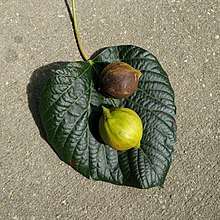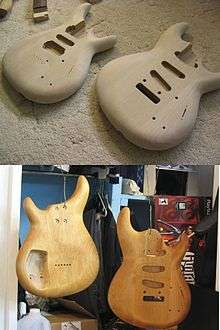Tung oil
Tung oil or China wood oil is a drying oil obtained by pressing the seed from the nut of the tung tree (Vernicia fordii). Tung oil hardens upon exposure to air (through polymerization), and the resulting coating is transparent and has a deep, almost wet look. Used mostly for finishing and protecting wood, after numerous coats, the finish can even look plastic-like. Related drying oils include linseed, safflower, poppy, and soybean oils.[1] The oil and its use are believed to have originated in ancient China and appear in the writings of Confucius from about 400 BC. Raw tung oil tends to dry to a fine, wrinkled finish; the English name for this is gas checking; this property was used to make wrinkle finishes, usually by adding excess cobalt drier. To stop this, the oil is heated to gas-proof it, and most oils used for coating are gas-proofed, also known as "boiled".
| Names | |
|---|---|
| IUPAC name
tung oil | |
| Other names
China wood oil; lumbang oil; tung oil paraformaldehyde; tungmeal; tungoel | |
| Identifiers | |
| ChemSpider |
|
| ECHA InfoCard | 100.029.338 |
| EC Number |
|
| UNII | |
CompTox Dashboard (EPA) |
|
| Properties | |
| Density | 0.937 g/ml at 25°C |
Refractive index (nD) |
1.52 (20°C) |
| Hazards | |
| Flash point | >110°C |
Except where otherwise noted, data are given for materials in their standard state (at 25 °C [77 °F], 100 kPa). | |
| Infobox references | |

The name is often used by paint and varnish manufacturers as a generic name for any wood-finishing product that contains the real tung oil or provides a finish that resembles the finish obtained with tung oil.[2]
History
The tung oil tree originates in southern China and was cultivated there for tung oil, but the date of cultivation remains unknown.[3] During the Song Dynasty, tung oil was used for waterproofing on ships.[4] The word "tung" is etymologically derived from the Chinese 桐 tóng.[5] The earliest references for Chinese use of tung oil is in the writings of Confucius around 500 to 400 BC[6][7][8][9]
Composition
The major fatty acids in tung oil and their concentration are listed in the table.
| Alpha-eleostearic acid | 82.0% |
| Linoleic acid | 8.5% |
| Palmitic acid | 5.5% |
| Oleic acid | 4.0% |
The primary constituent is a fatty acid with a chain of 18 linked carbon atoms or methylene units containing three conjugated double bonds. They are especially sensitive to autoxidation, which encourages cross linking of neighbouring chains, hence hardening of the base resin.
Uses
Wood finishing

Tung oil is very popular today because of two properties: first, it is natural or "green" product when it has dried. Second, after it cures (5 to 30 days, weather/temperature related), the result is a very hard and easily repaired finish, so it is used on boat decks and now on floors. The oil is often diluted with hydrocarbon thinner so its viscosity is very low and enables the oil to penetrate the finest grain woods. This thinning vehicle evaporates within 15 to 20 minutes and results in a totally green residual finish. When applied in many fine/thinner coats over wood, tung oil slowly cures to a matt/light satin look with slight golden tint (It is NOT a wet look/high gloss finish). Tung oil resists liquid water better than any other pure oil finish and does not darken noticeably with age and is claimed to be less susceptible to mould than linseed oil.[11] Most important, of all the oil finishes, tung oil is the only drying oil that polymerizes 100% (completely hardens). Linseed oil, for example, never completely hardens.
Since tung oil has become popular as an environmentally friendly wood finish, some products labelled as "tung oil" are actually blends containing other oils, varnishes, solvents, or chemical driers, and may even containing no tung oil at all[12] Products labeled Danish oil may be tung oil or they may be polymerized linseed oil. The product packaging will usually clearly state if it is pure tung oil.
Heating tung oil to about 500 °F (260 °C)[13] in an oxygen-free environment will substantially increase the viscosity and film-forming quality of the product. Most polymerized tung oils are sold mixed with mineral spirits to make them easier to work with. Limonene and D-limonene are less toxic alternatives for mineral spirits.
Oil-paper umbrella
The oil-paper umbrella is the traditional umbrella used in China, Japan, and other countries in the sinosphere, and was brought to Western countries through the Silk Road. Tung oil is the "oil" mentioned in the oil-paper umbrella, which is used to protect the paper from getting wet, and to make the umbrella waterproof.
Application
The traditional technique for applying pure tung oil is to dilute the oil 1:1 with solvent, then apply a succession of very thin films with a soft, lint-free cloth such as tee-shirt cotton. Dilutents range from traditional spirits of turpentine to any of the new citrus-based thinners to naphtha. The choice of thinner should be guided by how fast the coating needs to set. Naphtha works well in spray-on applications in well-ventilated studios. Primary coats may be laid down at a 1:1 oil-to-thinner ratio, and successive layers, if not absorbed into the wood, at higher solvent to oil concentrations. This technique brings out the deepest color of the wood while maintaining a matte finish.
Tung oil finishes that start with polymerized oils or tung oil preparations are best applied in the fat over lean principle: thinned pure oil is applied to deeply penetrate the surface, to fill pores. Straight oil is then applied moderately to adhere to the surface and provide a good base for the thick gloss layers. The polymerized oil is then applied thickly as a single layer, allowed to fully dry, is buffed smooth with very fine sandpaper, then 0000 steel wool. The surface is wiped clean with a moistened rag, then allowed to dry. A final coat is applied fairly thickly (the oil will smooth itself into a glass-like coating) and allowed to dry for two to three days. Rags soaked with tung oil can spontaneously combust (burst into flame).[14]
References
| Wikimedia Commons has media related to Tung oil. |
- Ulrich Poth, "Drying Oils and Related Products" in Ullmann's Encyclopedia of Industrial Chemistry Wiley-VCH, Weinheim, 2002. doi:10.1002/14356007.a09_055
- Tung Oil, WoodworkDetails.com
- David N. Keightley (1983). The Origins of Chinese Civilization. University of California Press. pp. 50–. ISBN 978-0-520-04229-2.
- Ebrey, Walthall, and Palais (2006), 133.
- "Tung oil". Merriam Webster. Retrieved 5 October 2012.
- McKeon, Thomas; Hayes, Douglas; Hildebrand, David; Weselake, Randall (2016). Industrial Oil Crops. AOCS Press (published March 8, 2016). p. 243. ISBN 978-1893997981.
- Xia, Wenwen (2015). An Investigation of Chinese Historical Grey Bricks of Soochow, Jiangsu and the Effect of Tung Oil Treatment (Masters thesis). University of Pennsylvania.
- "The History of Tung Oil". Sutherland Welles.
- Deyo, Ray (April 1, 2017). "Finishing Tips and Tricks" (PDF). American Association of Woodturners.
- Food and Agriculture Organization of the United Nations. "Minor oil crops - Individual monographs". Retrieved 2007-10-15.
- Flexner, Bob (1993). Understanding Wood Finishing. Pan Macmillan. p. 77. ISBN 0875965660.
- Flexner, pp. 71,79
- "Process for stabilizing and refining tung oil and product thereof". US Patent 2867639.
- "Archived copy". Archived from the original on 2015-05-15. Retrieved 2015-05-25.CS1 maint: archived copy as title (link)